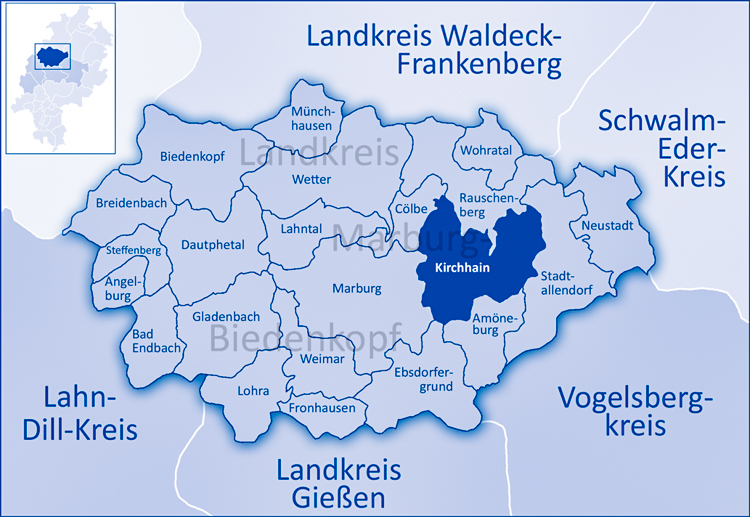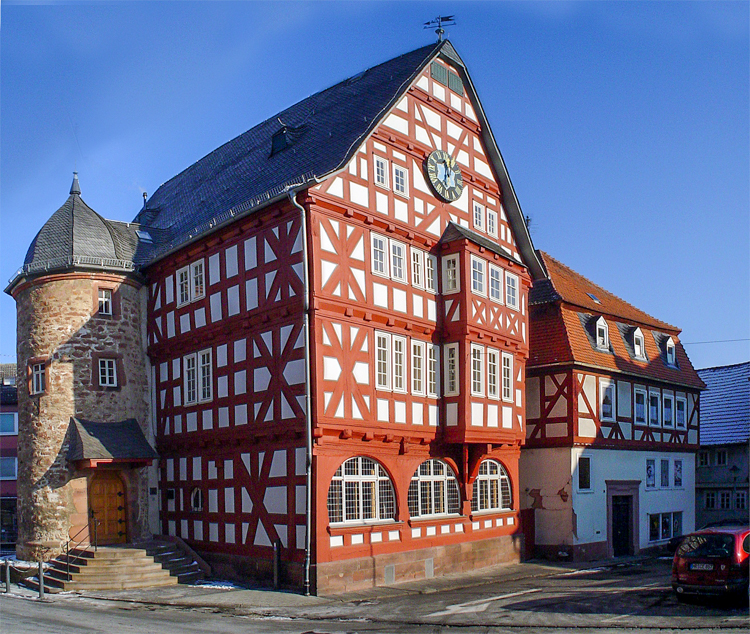Kirchhain, Marburg-Biedenkopf, Hesse, Germany

History of the City of Kirchhain
Kirchhain arose from the settlement of “Werploh” (hill with trees) and has been mentioned in documents since 1146. The varied history of the city is mainly determined by the Teutonic Knights and the location as a Hessian fortress against the influences of the Mainz sovereigns. The namesake of the city is clearly visible: the church in the middle of a group of trees stands above the city.
Especially in the city center there are many historically interesting buildings. The city church, the town hall on the marketplace and the building “Blue Lion”. There are also in the districts, some historic buildings and monuments.2
It is currently in the Marburg-Biedenkepf district of Hesse, Germany.

Kirchhain Historical Timeline
1146 In 1146 the settlement (Kirchhain) was first mentioned in a document under the name “Werphloh” (hill with trees). The region belonged at that time to the Landgraviates of Thuringia and Hesse, whereas the surrounding lands belonged to the Archbishops of Mainz. Time and again, the Hessians and Mainzers came to blows over who had ascendancy over these lands.
1238 The name Kirchhain appears for the first time in a deed of the Klosters Kalden.
1247-1264 As of the 13th century, the Landgraviate of Hesse further upgraded Kirchhain as a Hessian bulwark against Mainz’s center of Amöneburg so that they could control the region. Kirchhain then developed into the economic center of the Amøneburg Basin. In the War of the Thuringian Succession from 1247-1264, Hesse gained its independence and became a Landgraviate within the Holy Roman Empire.
1352 Kirchhain is mentioned in documents as a city. Mayors and aldermen of the city are requested to attach their seal to a certificate (Secretm Opodi Kychein). Kirchhain was presumably given town rights before 1348, but without any earlier documentary proof, the year 1352 has come to be seen as the official year of the town’s founding.
1412 Attack by the Mayor of Mainz in Amöneburg (Count Heinrich von Waldeck) – almost complete devastation and great fire in the city.
1525–1146 In 1146 the settlement (Kirchhain) was first mentioned in a document under the name “Werphloh” (hill with trees). The region belonged at that time to the Landgraviates of Thuringia and Hesse, whereas the surrounding lands belonged to the Archbishops of Mainz. Time and again, the Hessians and Mainzers came to blows over who had ascendancy over these lands.
1238 The name Kirchhain appears for the first time in a deed of the Klosters Kalden.
1247-1264 As of the 13th century, the Landgraviate of Hesse further upgraded Kirchhain as a Hessian bulwark against Mainz’s center of Amöneburg so that they could control the region. Kirchhain then developed into the economic center of the Amøneburg Basin. In the War of the Thuringian Succession from 1247-1264, Hesse gained its independence and became a Landgraviate within the Holy Roman Empire.
1352 Kirchhain is mentioned in documents as a city. Mayors and aldermen of the city are requested to attach their seal to a certificate (Secretm Opodi Kychein). Kirchhain was presumably given town rights before 1348, but without any earlier documentary proof, the year 1352 has come to be seen as the official year of the town’s founding.
1412 Attack by the Mayor of Mainz in Amöneburg (Count Heinrich von Waldeck) – almost complete devastation and great fire in the city.
1525 Prussia (German: Preußen) was a historically prominent German state that originated in 1525 with a duchy centered on the region of Prussia on the southeast coast of the Baltic Sea. It was de facto dissolved by an emergency decree transferring powers of the Prussian government to German Chancellor Franz von Papen in 1932 and de jure by an Allied decree in 1947. For centuries the House of Hohenzollern ruled Prussia, successfully expanding its size by way of an unusually well organized and effective army. Prussia, with its capital in Königsberg and from 1701 in Berlin, decisively shaped the history of Germany.
1526 The town of Kirchhain is the seat of the lower court of the Office Marburg.
1526 Probable visit by Dr. Martin Luther in the city (on the way to a conversation with Zwingli in Marburg).
1533 Construction of the town hall (landmark of the city).
1559 The “Weinhaus” (wine house) is built on the market square.
1562 Construction of the stair tower at the town hall.
1567 The territory was divided into Hesse-Cassel, Hesse-Darmstadt, Hesse-Rheinfels, and the also previously existing Hesse-Marburg. Kirchhain becomes part of Hesse-Cassel and remains so until 1803-1806 when the Landgraviate ended.
1618-1701 Brandenburg-Prussia – Based in the Electorate of Brandenburg, the main branch of the Hohenzollern intermarried with the branch ruling the Duchy of Prussia, and secured succession upon the latter’s extinction in the male line in 1618. Another consequence of the intermarriage was the incorporation of the lower Rhenish principalities of Cleves, Mark and Ravensberg after the Treaty of Xanten in 1614.
1618-1648 The Thirty Years’ War (1618-1648) was especially devastating. The Elector changed sides three times, and as a result Protestant and Catholic armies swept the land back and forth, killing, burning, seizing men and taking the food supplies. Upwards of half the population was killed or dislocated. Berlin and the other major cities were in ruins, and recovery took decades. By the Peace of Westphalia, which ended the Thirty Year’s War in 1648, Brandenburg gained Minden and Halberstadt, also the succession in Farther Pomerania (incorporated in 1653) and the Duchy of Magdeburg (incorporated in 1680).
1636 Kirchhain– From the 15th century, the important Lange Hessen and Cologne-Leipzig trade roads made of Kirchhain a road hub and thereby spurred on the town’s further economic development. Its good traffic connections, however, led to Kirchhain’s being occupied a few times during the Thirty Years’ War, becoming for a time the headquarters of various armies, and thereby having to suffer as troops were billeted in the town. In 1636, about 12,000 to 14,000 soldiers were being housed in and around the town. For the 1,000 or so townsfolk at that time, this was a tremendous burden. This would have been the time during which Ludwig Dörr and his family resided there.
1755 Final agreement on the borders between Hesse and Mainz and thus termination of the ongoing dispute between Amöneburg and Kirchhain.
1756-1763 Kirchhain had to put up with troubles in the Seven Years’ War (1756-1763) as its good traffic connections once again led troops to the town.
1803 Following the reorganization of the German states during the German mediatization of 1803, the Landgraviate of Hesse-Kassel was raised to Electorate of Hesse. The principality thus became known as Kurhessen, although still usually referred to as Hesse-Kassel.
1806 Hesse-Darmstadt, Prussia – Hesse-Darmstadt was elevated by Napoleon to the status of a Grand Duchy in 1806, becoming the Grand Duchy of Hesse. The Holy Roman Empire had survived over a thousand years when it was finally destroyed by Napoleon and the French in 1806.
1806 Confederation of the Rhine was formed initially from 16 German states by Napoleon after he defeated Austria and Russia at the Battle of Austerlitz. The Treaty of Pressburg, in effect, led to the creation of the Confederation of the Rhine, which lasted from 1806 to 1813, when Napoleon lost the Battle of Leipzig. See Figure 12, page 14.
1821 From 1821-1932, Kirchhain was the district seat of the newly created Kirchhain administrative district, until this was combined with the Marburg district in 1932. 1821. With the new district division, Kirchhain was elevated to the cou nty seat with the former offices Amöneburg, Kirchhain, Neustadt and Rauschenberg (5 cities and 37 minimalities).
1868 From 1868 – 1944 Hesse-Nassau was a province of the Kingdom of Prussia from 1868 to 1918, then a province of the Free State of Prussia until 1944. (See Figure 13, page 14) Hesse-Nassau was created as a consequence of the Austro-Prussian War of 1866 by combining the previously independent Hesse-Kassel (or Hesse-Cassel), the Duchy of Nassau, the Free City of Frankfurt, areas gained from the Kingdom of Bavaria, and areas gained from the Grand Duchy of Hesse (including part of the former Landgraviate of Hesse-Homburg from Hesse-Darmstadt). These regions were combined to form the province of Hesse-Nassau in 1868 with its capital in Kassel and re-divided into two administrative regions: Kassel and Wiesbaden. In April 1, 1929, the Free State of Waldeck became a part of Hesse-Nassau after a popular vote and became part of the Kassel administrative region. In 1935, the Nazi government abolished all states, so the provinces held little meaning. In 1944, Hesse-Nassau was split into the provinces of Kurhessen (capital of Kassel) and Nassau (capital in Wiesbaden). In 1945, after the end of World War II, these two provinces were merged and combined with the neighboring Hesse-Darmstadt to form the northern and western part of the newly founded state of Hesse. Parts of Nassau were also moved into the Rhineland-Palatinate.
1932 Kirchhain district was combined with Marburg district in 1932, ending its district city function.
1944-1945 Province of Kurhessen – was a province of Prussia within Nazi Germany between 1944 and 1945. Although all German states, including Prussia, had defacto been dissolved since 1933, the Nazi government formally dissolved the Prussian Province of Hesse-Nassau into two provinces on April 1, 1944: Kurthessen and the Province of Nassau. The name Kurhessen comes from the former Electorate of Hesse-Kassel (Hesse-Cassel; 1803-1866) which, following the Austro-Pussian War, Prussia annexed to form part of the Province of Hesse-Nassau. Following the end of World War II, Kurhessen fell under American administration. The province was dissolved by the occupying US forces on September 19, 1945 and formed part of the administrative zone of Greater Hesse. Just over a year later, Greater Hesse became the modern German state of Hesse.
1974 The district Marburg-Biedenkopf was created in 1974 when the districts of Marburg, Biedenkopf and the former urban district of Marburg were merged.
2000 From 2000-2003 Renovation of the town hall.
Kirchhain Place Name Changes Timeline
Below is a list of place name timeline as best as I could figure it out for the town of Kirchhain, which you may find variants of in genealogies and webgens. You may also find a variety of abbreviations, such as HeNas for Hesse-Nassau. I used the place names at the time of event whenever possible.
1146-Abt 1348 – Werphloh, Hesse, Holy Roman Empire
1348 – Kirchhain, Hesse, Holy Roman Empire
1525 – Kirchhain, Hesse, Prussia, Holy Roman Empire
1567 – Kirchhain, Hesse-Cassel, Prussia, Holy Roman Empire
1618 – Kirchhain, Hesse-Cassel, Brandenburg-Prussia, Holy Roman Empire
1701 – Kirchhain, Hesse-Cassel, Prussia, Holy Roman Empire
1803 – Kirchhain, Kurhessen (although still referred to as Hesse-Cassel), Prussia, Holy Roman Empire
1806 – Kirchhain, Hesse-Cassel, Prussia, Confederation of the Rhine
1807 – Kirchhain, Hesse-Cassel, Westphalia, Confederation of the Rhine
1814 – Kirchhain, Hesse-Cassel, German Confederation
1821 – Kirchhain, Kirchhain, Hesse-Cassel, German Confederation
1848 – Kirchhain, Kirchhain, Hesse-Cassel, (German Confederation was dissolved, but not replaced, so re-established in 1850).
1850 – Kirchhain, Kirchhain, Hesse-Cassel, German Confederation
1866 – Kirchhain, Kirchhain, Hesse-Cassel, Prussia, German Confederation
1867 – Kirchhain, Kirchhain, Hesse-Cassel, Prussia, North German Confederation
1868 – Kirchhain, Kirchhain, Hesse-Nassau, Prussia, North German Confederation
1871 – Kirchhain, Kirchhain, Hesse-Nassau, Prussia, German Empire
1918 – Kirchhain, Kirchhain, Hesse-Nassau, Prussia, Germany
1932 – Kirchhain, Marburg, Hesse-Nassau, Germany
1944 – Kirchhain, Marburg, Hesse-Nassau, Germany
1945 – Kirchhain, Marburg, Hesse-Darmstadt, Germany
1974 – Kirchhain, Marburg-Biedenkopf, Hesse, Germany
- By Andreas Trepte - Graphics by Andreas Trepte.Feel free to ask for a version in the language of your wikipedia!, CC BY-SA 3.0, https://commons.wikimedia.org/w/index.php?curid=1131317
- Kirchhain, City - Bürgerinfo (Brochure), History at FindCity Website. (https://www.findcity.de/?m=stadt-kirchhain-buergerinfo-35274a&p=00000003, Accessed 29 June 2019).
- By Andreas Trepte - Own work, CC BY-SA 2.5, https://commons.wikimedia.org/w/index.php?curid=542753
